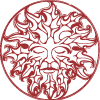
Antler Dancing - November 2008
Most revelers, when they tell friends about the Christmas Revels, include the moment when the stage goes almost dark, and men carrying deer antlers prance about the main floor. Of course they’re describing the Abbots Bromley Horn Dance, a ritual moment that has become closely identified with our celebration of the Winter Solstice.
 The dance consists of a line of dancers in walking gait, weaving into repeated serpentine and facing figures, punctuated by light clashes of the hand-held antlers. There are six deer dancers, and four costumed “supernumeraries”. These accompanying figures are dubbed Hobby Horse, Bowman, Fool and Maid Marian (or man/woman). They are accompanied by a melodeon and a triangle player, although in Revels we customarily employ a recorder.
The dance consists of a line of dancers in walking gait, weaving into repeated serpentine and facing figures, punctuated by light clashes of the hand-held antlers. There are six deer dancers, and four costumed “supernumeraries”. These accompanying figures are dubbed Hobby Horse, Bowman, Fool and Maid Marian (or man/woman). They are accompanied by a melodeon and a triangle player, although in Revels we customarily employ a recorder.
Like so many traditional celebrations, the Horn Dance (or more properly, Antler dance) has a long and ultimately obscure history. The earliest report of its performance is at the Barthelmy Fair in Staffordshire, England in August of 1226. Today the Horn Dance takes place annually on Wakes Monday, a date falling in early September. The antlers, large sets from caribou or reindeer, mounted on small carved deer heads are kept in the parish hall of the St. Nicholas Church in Abbots Bromley. There are six sets - three painted white and three painted blue (actually brown, but the earlier coat of blue paint shows through). How these antlers came to this parish is a mystery. In the 1970’s, one of the white sets was damaged, and while being repaired underwent carbon dating which showed it to be over 900 years old. Since there were no Reindeer in England in 1065, the horns are presumed to have come from Scandinavia.
The horns are the property of the Abbots Bromley parish council and never are allowed to leave the Parish (a smaller, lighter set of red deer antlers are used for practice and for guest appearances elsewhere). After collecting the horns from the church at eight o'clock in the morning, the Horn Dancers perform their dance at locations throughout the village and its surrounding farms and pubs, a walk of about 10 miles (or 16 kilometres).
In Revels we perform the dance as notated by our old friend, the songcatcher Cecil Sharpe. He recorded that the dancers all came from only one or two families in Abbots Bromley who had passed the steps and patterns down from generation to generation for as long as anybody could remember (that phrase again!). Also, the melody that had come to be associated with the dance shared a similar heritage. It was a tune that the elderly village wheelwright, a man named Robinson had learnt from his grandfather, who played it end of the eighteenth century. And so the bouncy little jingle that we associate with the dance came to be called “The Wheelwright Robinson’s Tune”.
It is interesting to note that in modern day Staffordshire, there are a variety of tunes used with the dance, and the performance has no particular association with the Winter Solstice. As the ritual has come to be “owned” by many communities outside of Abbots Bromley, celebrants have added their own special grace notes to the stepping and costuming. Some dance it on Mayday morn and it has become a staple of traditional music camps where it is commonly danced by women and children. I think this speaks to the power of this ritual and the durability of tradition. It can be successfully reshaped by each group of celebrants as they embrace its essence and tailor the performance to make it their own.
In the California Revels, we have reserved its performance for the darkest point in the Solstice show, where its haunting power is allowed to take hold through the almost hypnotic interweaving of the figures and tune. The ten men who dance it here employ a slightly vaulting step that is noticeably different from the way it is performed even in other Revels cities. Our fool plays the triangle, a boy dances the archer, and Maid Marian is invariably a robust, bearded man.
Of course the question arises, usually at a safe remove from the magic of the performance itself, concerning the meaning of it all. Why has this dance been performed over all of these centuries? What is it supposed to do? The answers to these questions are rife with speculation. Some feel the dance is supposed to guarantee success in the hunt, others point to a historical conflict between villagers and a surly gamekeeper, others posit a linkage through the Robin Hood allusions to the Green Man, and still others ferret out the Christian iconography of the stag figures.
There is no logical answer to the question of the meaning of the Abbots Bromley dance. It is a riddle whose solution is best left to intuition. One explanation is as good as another - and ultimately as wrong. It is a mystery that fares better in the realm of experience than understanding. Each of us feels the power of this ritual and we respond from a place that is deeper than the conscious mind can fathom. It is primitive magic and the awareness of the moment draws us together in a wild and powerful way.
Here is a link to the Abbots Bromley village site.
And here’s a video of the Horn dance.
- David Parr, Artistic Director



